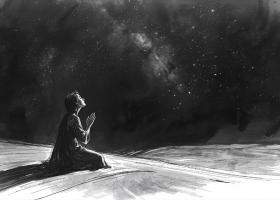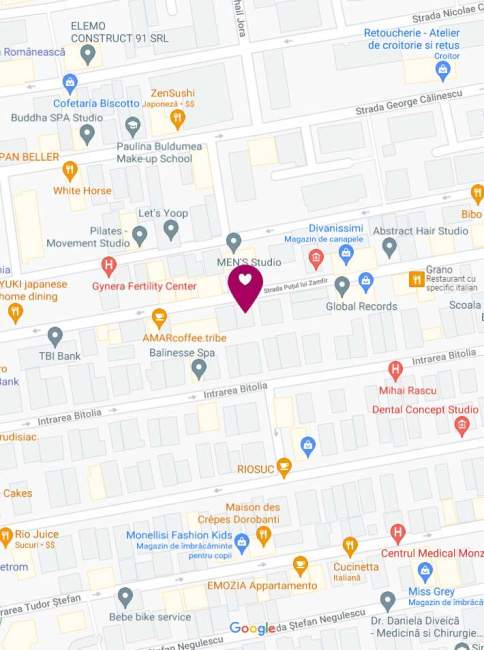Mostenirea Evei?
Imaginea Evei seducatoarea din biblie a avut un impact extreme de negative in toate privintele in traditie iudeo-crestina.
Toate femeile au crezut ca au mostenit de la mama lor biblica Eva,vina si siretenia ei.
In consecinta ele sunt inferioare moral,slabe,nedemne de incredere.
Menstruatie,graviditatea si nasterea au fost considerate o pedeapsa dreapta pentru vina eternal, pentru sexul feminine a fost blestemat. Cu scopul de a evidential impactul negativ al Evei biblice asupra descendentilor femei vom privi putin la scrierile foarte importante iudaice si crestine din toate timpurile .
Vom incepe din cu vechiul testament si vom cauta fragmente din ceea ce se numeste �Literatura Inteleapta�
Gasim in Ecleziastul (7:26) �si am gasit ca mai amara decat moartea este femeia a carei inima este o cursa si un lant si al carei maini sunt niste lanturi; cel placut Domnului scapa de ea dar cel pacatos este prins de ea.�
�Iata ce am gasit, zice Ecleziastul cercetand lucrurile unul cate unul ca sa le patrund rostul;� (7:27)
�Iata ce-mi cauta si acum sufletul si n-am gasit: din o mie am gasit un om, dar o femeie n-am gasit in toate astea.� (7:28)
Intr-o alta sursa ebraica gasim ca in biblia catolica putem citi:�Nu exista rautate egala cu rautatea femei. Pacatul a inceput de la o femeie si datorita ei noi toti vom muri� Ecleziastul (25:19-24)
Rabini evrei au intocmit o lista cu cele noua blesteme la care este supusa femeia si care sunt efectul Caderii ei. Femeii i-au fost date noua blesteme si moartea;povara sangelui menstrual si a sangelui virginitatii; povara sarcinii si a nasterii; povara de a-si acoperii capul in fiecare dimineata ea isi va gauri (strapunge) urechea asemeni sclavilor permanenti sau fetelor sclave care ii servesc pe stapanii lor; ea nu poate fii martor credibil si dupa toatea aceestea, moartea. In zilele noastre barbatii evrei ortodocsi spun la rugaciunea de dimineata: �Binecuvantat esti Dumnezeu, regale universului, pentru ca nu m-ai creat pe mine femeie.�
Cu alte cuvinte, multumesc Doamne, in fiecare dimineata pentru ca �m-ai creat in conformitatea cu bunatatea ta.�
O alta rugaciune pe care o gasim in multe din cartile iudaice de rugaciune: �Laud pe Dumnezeu ca nu m-a crea aerian, Laud pe Dumnezeu ca nu m-a creat femeie, Laud pe Dumnezeu ca nu m-a creat ignorant.�
Eva biblica a jucat de departe un rol si mai mare in crestinism comparative cu iudaismul.
Pacatul ei a fost pivotal credintei crestine, deoarece conform conceptiei crestine motivul misiunii lui Isus Cristos pe pamant este stavilirea neascultarii lui Dumnezeu de catre Eva.
Ea a pacatuit si apoi l-a corupt pe Adam sa comita aceasi fapta. In consecinta Dumnezeu i-a expulzat pe amandoi din rai pe pamant, toti au fost blestemati din cauza lor.
Ei au transmis urmasilor pacatul lor care nu a fost iertat de Dumnezeu, toti descendentii lor si toata rasa umana este nascuta in pacat. Cu scopul de a curate rasa umana de al ei �pacat originar� Dumnezeu l-a sacrificat pe cruce pe Isus care este considerat fiu lui Dumnezeu.
Deci Eva este responsabila pentru propria ei greseala.pentru pacatul sotului sau pentru pacatul originar al intregii omenirii si de moartea fiului lui Dumnezeu.
Ce crezi despre ficele ei? Sunt pacatoase ca si ea si trebuiesc tratate ca atare.
Asculta tonul sever al Sf.Paul care spune in noul testament: �Femeia sa primeasca invatatura in tacere, cu toata supunerea�
�Femeii nu-I dau voie sa invete pe altii, nici sa se ridice mai presus de barbat ci sa ramane in tacere�
�Caci intai a fost intocmit Adam, si apoi Eva�
�Sin u Adam a fost amagit; ci femeia s-a facut vinovata de calcarea poruncii.� Timotei (2:11-14)
Sf.Terulian a fost mult mai dur decat Sf.Paul cand a vorbit cu �cele mai bune iubite surori in credinta�
El a spus:�Voi sttiti ca sunteti la fel ca Eva? Dumnezeu a hotarat ca femeile sa traiasca astfel; vinovatul asa trebuie sa traiasca. Voi sunteti poarta raului. Voi ati fost calea spre copacul interzis. Eva e primul dezertor de la legea divina. Ea e cea care l-a convins pe Adam si care nu a atacat sufficient raul. Ea a distrus usor creatie lui Dumnezeu-omul. Drept urmare chiar fiul lui Dumnezeu a platit dezertarea ei.�
Sf.Augustin a gandit exact ca predecesorul sau. El a scris unui prieten:�care este diferenta dintre femei chiar daca este o sotie sau o mama [�] Refuz sac red ca femeia poate fi om, functia sa exclusive sa exclusive este de a naste copii.�
Sf.Toma de Aquino cateva secole mai tarziu considera femeia plina de defecte.
�Cu privire la natura individuala, femeia este plina de defecte si nelegitima, pentru ca ea este inca Eva cea amagitoare si din aceasta cauza noi trebuie san e ferim de orice femeie.�
Reformatorul Martin Luther nu vedea niciun beneficiu de pe urma femei decat cel de a adduce pe lume cati mai multi copii. El spunea: � Daca ele se vor imbolnavii, sau chiar murii nu este nici o problema. Lasati le sa moara la nastere pentru ca ele de asta exista.�
Din nou si din nou toate femeile sunt denigrate din cauza imaginii Evei cea amagitoare, datorita relatarilor din Geneza.
Rezumand conceptia iudeo-crestina despre femeia a fost otravita de credinta in natura pacatoasa a Evei si a urmasilor sai de sex feminine.
Daca ne indreptam atentia spre ceea ce afirma Coranul despre femeie vom realize imediat ca parerea islamica despre femeia este radical diferita de conceptia iudeo-crestina.
Sa lasam insusi Coranul sa vorbeasca:
�Musulmanilor si musulmanelor,dreptcredinciosilor si dreptcredincioaselor,celor supusi si celor supuse,celor iubitori de adevar si celor iubitoare de adevar, celor statornici si celor statornice, celor smeriti si celor smerite, celor ce dau milostenie si acelora dintre femei ce dau milostenie, celor care postesc si acelora care postesc dintre femei, celor care isis pazesc castitatea lor si acelora dintre femei care si-o pazesc, celor care il pomenesc pe Allah Preainaltul mereu si acelora dintre femei care il pomenesc, Allah Preainaltul le-a pregatit iertarea si rasplata mare.� (Al Ahzab:35)ost prigoniti pe Calea mea, care au luptat si
�Domnul lor le-a raspuns : Eu nu lass a se piarda nici o fapta implinita de vreunul din voi barbat sau femeie, deopotriva unul ca altul! Iar pe cei care au pribegit, care au fost alungati din caminele lor, care au fost prigoniti pe Calea mea, care au luptat si au fost omorati, pe ccale voi sa-ispasesc de faptele lor rele sis a ii fac sa intre in Gradini pe sub care curg paraie, drept rasplata din partea lui Allah. La Allah Preainaltul se afla buna rasplata!� (Al Imran:195)
�Pe cel care face o fapta buna barbat sau femeie si este credincios l vom darui noi cu o viata mai buna. Si Noi ii vom rasplati pe ei dupa faptele cele mai bune pe care le-au savarsit.� (An Nahl :97)
�Cel care savarseste o fapta rea nu va fi rasplatit decat cu una asemanatoarea cu ea, iar cel care savarseste o fapta buna fie el barbat sau femeie si este credincios acela va intra in Rai, unde va primi cele de trebuinta, fara socoteala.� (Ghafir:40)
Este clar ca femeia nu este diferita de barbat. Ei sunt amandoi creatii al lui Dumnezeu al carui sublime scop pe pamant este s ail adore pe Dumnezeu lor, sa savarseasca fapte bune, sa evite raul si ca ei amandoi vor fi rasplatiti.
Coranul nu mentioneaza niciodata ca femeia este poarta raului sau ca omul este imaginea lui Dumnezeu femeile si barbatii sunt creatii sale. Conform cu Sf.Coran rolul femei pe pamant nu se limiteaza doar la a naste. Ei I se cere sa faca fapte bune asa cum I se cere si barbatului. Coranul nu spune niciodata ca femeia nu are dreptul sa existe.
Din contra recomanda tuturor credinciosilor, femei sau barbate, sa urmeze exemplul acestor doua femei ideale, Fecioara Maria si sotia lui faraon.
�Si Allah Preainaltul a dat-o drept pilda pentru aceia care cred pe femeia lui faraon care a zis: Doamne dureaza-mi mie o casa langa tine in Rai si mantuieste ma pe mine de faraon si de fapta sa si mantuieste ma pe mine de neamul de nelegiuti!/Si la fel sip e Maria, fiica lui Imran care a ramas neprihanita si am suflat in ea din Duhul nostrum. Si ea a crezut in cuvintele Domnului ei si in scripturile Sale si a fost ea dintre supusi cu statornicie� (At-Tahrim: 11-12)
|
PATETIC!
Nu exista pedeapsa mai mare decat sa fii femeie musulmana!
De ce nu ai citat si sura 3:14 daca-i asa de bine?
Hai sa vedem cum sta treaba in Nould testament mai inainte de a trece la Coran,

Femeia in Noul Testament:
Biblical references promoting gender equality:
John 1:12: All people, men and women, have the opportunity to become children of God - presumably without regard to gender, race, sexual orientation, nationality, etc.
Acts 2:1-21: At the time of Pentecost, the Holy Spirit was described as entering both men and women. In Verse 17, Peter recites a saying of the prophet Joel that talks about sons and daughters; Verse 18 talks about men and women.
Acts 9:36: Paul refers to a woman (Tabitha in Aramaic, Dorcas in Greek, Gazelle in English) as a Christian disciple.
Acts 18:24-26 describes how a married couple, Priscilla and Aquila, both acted in the role of pastor to a man from Alexandria, called Apollos. Various translations of the Bible imply that they taught him in the synagogue (Amplified Bible, King James Version, Rheims, New American Standard, New American, New Revised Standard) However, the New International Version have an unusual translation of this passage. The NIV states that the teaching occurred in Priscilla's and Aquila's home.
Acts 21:9: Four young women are referred to as prophetesses.
Romans 16:1: Paul refers to Phoebe as a minister (diakonos) of the church at Cenchrea. Some translations say deaconess; others try to downgrade her position by mistranslating it as "servant" or "helper".
Romans 16:3: Paul refers to Priscilla as another of his "fellow workers in Christ Jesus" (NIV) Other translations refer to her as a "co-worker". But other translations attempt to downgrade her status by calling her a "helper". The original Greek word is "synergoi", which literally means "fellow worker" or "colleague." 4
Romans 16:7: Paul refers to a male apostle, Andronicus and a female apostle, Lunia, as "outstanding among the apostles" (NIV) The Amplified Bible translates this passage as "They are men held in high esteem among the apostles." The Revised Standard Version shows it as "they are men of note among the apostles." The reference to them both being men does not appear in the original Greek text. The word "men" was simply inserted by the translators, apparently because the translators' minds recoiled from the concept of a female apostle. Many translations, including the Amplified Bible, Rheims New Testament, New American Standard Bible, and the New International Version simply picked the letter "s" out of thin air. They converted the original "Junia" (a woman's name) into "Junias" (a man's name) in order to warp St. Paul's original writing by erasing all mention of a female apostle. Junia was first converted into a man only in the "13th century, when Aegidius of Rome (1245-1316 CE) referred to both Andronicus and Junia as "honorable men." 5
1 Corinthians 1:11: Chloe is mentioned as the owner of a house where Christian meetings were held. There is some ambiguity as to whether the women actually led the house churches. Similar passages mention, with the same ambiguity:
The mother of Mark in Acts 12:12, and
Lydia in Acts 16:14-5, and 40, and
Nympha in (Col 4:15).
1 Corinthians 12:4-7: This discusses gifts that the Holy Spirit gives to all believers, both men and women. The New International Version obscures this message; in Verse 6 is translated "all men", whereas other translations use the terms "all", "all persons", "in everyone", and "in all."
1 Corinthians 16:3: Paul refers to a married couple: Priscilla and Aquila as his fellow workers in Christ Jesus.
2 Corinthians 5:17: "Therefore if anyone is in Christ, he is a new creation..." (NIV). Again "anyone" appears to mean both men and women.
Galatians 3:28: "There is neither Jew nor Greek, slave nor free, male nor female, for you are all one in Christ Jesus." (NIV) This is perhaps the most famous passage in the New Testament that assigns equal status to individuals of both genders (and all races, nationalities and slave status).
Philippians 4:2: Paul refers to two women, Euodia and Syntyche, as his coworkers who were active evangelists, spreading the gospel.
Philemon 2: Paul writes his letter to "Apphia, our sister" and two men as the three leaders of a house church.
1 Peter 4:10-11: This passages discusses all believers serving others with whatever gifts the Holy Spirit has given them, "faithfully administering God's grace in its various forms." (NIV) Presumably this would mean that some women are given the gift of being an effective pastor, and would have been expected exercise that gift.
|
Jesus' interactions with women is an important element in the theological debate about Christianity and women. Whereas certain modern theologians argue that Jesus was more of an egalitarian than later Church leaders, others maintain that his opposition to divorce and adultery is rather consistent with Middle Eastern patriarchal social norms. [1]
Contents
[hide]
* 1 High number of references to women
o 1.1 Female disciples
* 2 Mary, mother of Jesus
* 3 Mary of Magdala and others
o 3.1 Mary Magdalene
o 3.2 The woman who touched Jesus' garment
o 3.3 Jesus and the woman taken in adultery
o 3.4 The woman at the well in Samaria
* 4 Mary and Martha
o 4.1 Tension over roles
o 4.2 The grieving sisters
o 4.3 The anointing at Bethany
* 5 Jesus on family relationships
* 6 References
[edit] High number of references to women
According to New Testament scholar Dr. Frank Stagg and classicist Evelyn Stagg, the synoptic Gospels of the canonical New Testament[2] contain a relatively high number of references to women. The Staggs find no recorded instance where Jesus disgraces, belittles, reproaches, or stereotypes a woman. These writers claim that examples of the manner of Jesus are instructive for inferring his attitudes toward women and show repeatedly how he liberated and affirmed women.[3] According to one story, an unnamed Gentile woman taught Jesus that the ministry of God is not limited to particular groups and persons, but belongs to all who have faith.[Mk. 7:24-30] [Matt. 15:21-28] [4]
[edit] Female disciples
The gospels of the New Testament, written toward the last quarter of the first century CE, often mention Jesus speaking to women publicly and openly against the social norms of the time.[5] From the beginning, Jewish women disciples, including Mary Magdalene, Joanna, and Susanna, had accompanied Jesus during his ministry and supported him out of their private means.[Lk. 8:1-3] [6]
Kenneth E. Bailey spent 40 years as a Presbyterian professor of New Testament in Egypt, Lebanon, Jerusalem and Cyprus. He writes about Christianity from a Middle Eastern cultural view.[7] He finds evidence that Jesus had women disciples in several New Testament passages. He first cites the reported occasion when Jesus� family appeared and asked to speak with him. Jesus replied:
"Who is my mother, and who are my brothers?" And stretching out his hand towards his disciples, he said, "Here are my mother and my brothers! For whoever does the will of my Father in heaven is my brother, and sister, and mother."
� Matthew 12:46-50, emphasis added by Bailey
Bailey argues that according to Middle Eastern customs, Jesus could not properly have gestured to a crowd of men and said, "Here are my brother, and sister, and mother." He could only have said that to a crowd of both men and women. Therefore, the disciples before him were composed of men and women.
[edit] Mary, mother of Jesus
Main articles: Mary, mother of Jesus, Mother of God, and Theotokos
Jesus in the Temple in Jerusalem[Lk. 2:41�52] The canonical Gospels offer only one story about Jesus as a boy�Luke's story about the boy Jesus in the Jerusalem Temple. According to Luke, his parents, Joseph and Mary, took the 12-year-old Jesus to Jerusalem on their annual pilgrimage to the Passover. Mary and Joseph started their journey home without Jesus, thinking he was somewhere in the caravan with kinsmen or acquaintances. When his parents found him three days later, Mary said, "Son, why have you treated us like this? Your father and I have been anxiously searching for you." The boy Jesus respectfully but firmly reminded her of a higher claim he must answer: "Didn't you know I had to be about my Father's business?"[8]:103-104, 224 It is noteworthy that in obedience to his parents Jesus left and was subject to them.
The wedding at Cana of Galilee[Jn. 2:1�11] Mary told Jesus the wine was in short supply. Today his reply may seem curt: "Woman, what have I to do with you? My hour is not yet come."[Jn. 2:4]
Neither here nor elsewhere does Jesus renounce the mother-son relationship as such, but here, as in Luke 2:49, he declares his vocational (ministerial) independence of his mother. He has an "hour" to meet, and Mary, though his mother, can neither hasten nor hinder its coming.[9]
Most scholars believe that in Jesus' reply to his mother there was no disrespect. According to Matthew Henry's Commentary, he used the same word when speaking to Mary with affection from the cross.[10]
Scholar Lyn M. Bechtel disagrees with this reading. She writes that the use of the word "woman" in reference to Jesus' mother is "startling. Although it would not be improper or disrespectful to address an ordinary woman in this way (as he often does: see John 4:21, John 8:10, John 20:13-15), it is inappropriate to call his mother 'woman'" (Bechtel 1997, p. 249). Bechtel further argues that this is a device Jesus uses to distance himself from Judaism.
However, Bishop William Temple suggests there is no English phrase that represents the original "Woman, leave me to myself." "In the Greek it is perfectly respectful and can even be tender�as in John 19:27�. We have no corresponding term; 'lady' is precious, and 'madam' is formal. So we must translate simply and let the context give the tone."[11]
[edit] Mary of Magdala and others
[edit] Mary Magdalene
Main article: Mary Magdalene
Mary Magdalene (also called Miriam of Magdala) is among the women depicted in the New Testament who accompanied Jesus and his twelve apostles, and who also helped to support the men financially.[Lk. 8:2�3] According to Mark 15:40, Matthew 27:56, John 19:25, and Luke 23:49, she was one of the women who remained at Jesus' crucifixion. The New Testament says she saw Jesus laid in a tomb. Mark 16:9 reports that after his resurrection, Jesus appeared first to Mary Magdalene. The New Testament also says that Jesus had cast seven demons out of her.
For centuries, Mary Magdalene had been incorrectly identified in Western Christianity as an adulteress and repentant prostitute, although nowhere does the New Testament identify her as such. Discoveries of new texts and critical insight have now proven that portrait of Mary is entirely inaccurate. According to Harvard theologian Dr. Karen King, Mary Magdalene was a prominent disciple and leader of one wing of the early Christian movement that promoted women's leadership.[4]
King cites references in the Gospel of John that the risen Jesus gives Mary special teaching and commissions her as an "apostle to the apostles." She is the first to announce the resurrection and to play the role of an apostle, although the term is not specifically used of her (though, in Eastern Christianity she is referred to as "Equal to the Apostles"). Later tradition, however, names her as "the apostle to the apostles." King writes that the strength of this literary tradition makes it possible to suggest that historically Mary was a prophetic visionary and leader within one sector of the early Christian movement after the death of Jesus.[4]
Asbury Theological Seminary Bible scholar Ben Witherington III confirms the New Testament account of Mary Magdalene as historical: "Mary was an important early disciple and witness for Jesus."[12] He continues, "There is absolutely no early historical evidence that Miriam's relationship with Jesus was anything other than that of a disciple to her Master teacher."
Jeffrey Kripal, Chair of Rice University's Department of Religious Studies, writes that Christian Gnostic texts put Mary Magdalene in a central position of authority, but these texts were excluded from orthodox Biblical canons. Kripal describes Mary Magdalene as a tragic figure who maintained an important role later diminished by the male church leadership (Kripal 2007, p. 51). Kripal explains that gnostic texts suggest an intimate, possibly sexual relationship between Jesus and Mary Magdalene, but that Jesus' sexuality is absolutely ambiguous based on the available evidence: "The historical sources are simply too contradictory and simultaneously too silent on the matter" (Kripal 2007, p. 50).
According to Kripal, the gnostic texts "consistently [present] Mary as an inspired visionary, as a potent spiritual guide, as Jesus' intimate companion, even as the interpreter of his teaching" (Kripal 2007, p. 52).
Kripal writes that theologies of the European Middle Ages likely invented the notion of a sexual relationship between Mary Magdalene and Jesus: "The medieval Catharists and Albigensians, for example, held that Mary was Jesus's concubine. The great Protestant reformer Martin Luther also assumed a sexual relationship between the two, perhaps to give some historical precedent for his own dramatic rejection of Catholic celibacy" (Kripal 2007, p. 52).
[edit] The woman who touched Jesus' garment
Jesus sometimes touched the "untouchables" and let them touch him. Among the things considered defiling (disqualifying one for the rituals of religion) was an issue of blood, especially menstruation or hemorrhage. One such woman had been plagued with a flow of blood for 12 years, no one having been able to heal her. She found the faith in a crowd to force her way up to Jesus, approaching him from behind so as to remain inconspicuous, and simply touching his garment.[Mk. 5:27] When she touched Jesus' garment, the flows of blood stopped. Jesus turned and asked who touched him. The disciples tried to brush aside the question, protesting that in such a crowd no individual could be singled out. Jesus pressed his inquiry and the woman identified herself and declared to the crowd the blessing that had come to her. Jesus treated her as having worth, not rebuking her for what the cultic code of holiness would have considered as having defiled him. Rather, he relieved her of any sense of guilt for her seemingly rash act and said, "Daughter, your faith has saved you. Go in peace!"[Mk. 5:34]
Fontaine writes, "The 'chutzpah' shown by the woman who bled for 12 years as she wrests her salvation from the healer's cloak is as much a measure of her desperation as it is a testimony to her faith" (Fontaine 1996, p. 291). She writes that "the Bible views women as a group of people who are fulfilled, legitimated, given full membership into their community, and cared for in old age by their children" (Fontaine 1996, p. 290), and that barren women risked ostracism from their communities. Fontaine notes that when disabled people are healed, the act "emphasizes primarily the remarkable compassion of the one doing the good deed, not the deserving nature or dignity of the recipient" (Fontaine 1996, p. 290).
[edit] Jesus and the woman taken in adultery
Main article: Jesus and the woman taken in adultery
In John 7:53�8:11 Jesus was teaching in the Temple in Jerusalem. Some scribes and Pharisees interrupted his teaching as they brought in a woman who had been taken in the very act of adultery. They stood her before him, declared the charge, reminded him of Moses' command that such women be stoned, and then asked, "What do you say?" After a time of silence, Jesus stooped down and wrote with his finger on the ground. The text includes no hint of what he wrote. The woman's accusers were after Jesus, not just her. She to them was a worthless object to be used to trap Jesus. Finally, Jesus stood up and said to the accusers, "Let the one among you who is without sin cast the first stone." He stooped down once more and again wrote on the ground. In his answer Jesus did not condone adultery. He compelled her accusers to judge themselves and find themselves guilty�of this sin and/or others. No one could pass the test, and they slipped out one by one, beginning with the eldest.
When Jesus and the woman were finally alone, he asked her a simple question, "Woman, where are they? Did no one condemn you?" She simply replied, "No one, Lord." His final word to the woman was one of affirmation and commission: "Neither do I condemn you. Go, and from now on sin no more." While acknowledging that she had sinned, he turned her in a new direction with real encouragement. Jesus rejected the double standard for women and men and turned the judgment upon the male accusers. His manner with the sinful woman was such that she found herself challenged to a new self-understanding and a new life.[13]
[edit] The woman at the well in Samaria
The long account about Jesus and a woman of Samaria, found in John 4:1�42 is highly significant for understanding Jesus in several relationships: Samaritans, women, and sinners. By talking openly with this woman Jesus crossed a number of barriers which normally would have separated a Jewish teacher from such a person as this woman of Samaria. Jesus did three things that were highly unconventional and astonishing for his cultural-religious situation:
1. He as a man discussed theology openly with a woman.
2. He as a Jew asked to drink from the ritually unclean bucket of a Samaritan.
3. He did not avoid her, even though he knew her marital record of having had five former husbands and now living with a man who was not her husband.
The disciples showed their astonishment upon their return to the well: "They were marveling that he was talking with a woman.[Jn. 4:27] A man in the Jewish world did not normally talk with a woman in public, not even with his own wife. For a rabbi to discuss theology with a woman was even more unconventional. Jesus did not defer to a woman simply because she was a woman. He did not hesitate to ask of the woman that she let him drink from her vessel, but he also did not hesitate to offer her a drink of another kind from a Jewish "bucket" as he said to her, "Salvation is of the Jews."[Jn. 4:22] Salvation was coming to the Samaritan woman from the Jews. Although she was a Samaritan, she needed to be able to drink from a Jewish "vessel" (of salvation) and Jesus no more sanctioned Samaritan prejudice against Jew than Jewish prejudice against Samaritan.
The key to Jesus' stance is found in his perceiving persons as persons. He saw the stranger at the well as someone who first and foremost was a person�not primarily a Samaritan, a woman, or a sinner. This evangelized woman became an evangelist. She introduced her community to "a man" whom they came to acclaim as "the Savior of the world."[Jn. 4:42] Jesus liberated this woman and awakened her to a new life in which not only did she receive but also gave. The Bible says she brought "many Samaritans" to faith in Christ (v. 39). If the men in John 1 were the first "soul winners," this woman was the first "evangelist" in John's gospel.[14]
[edit] Mary and Martha
Luke and John show that Jesus had a close relationship with the sisters Mary and Martha.[15] They are featured in three major stories:
1. A tension between the two sisters over roles[Lk. 10:38�42)]
2. Grief at the death of their brother Lazarus, followed by his being raised,[Jn. 11:1�44] and
3. The anointing of Jesus by Mary (explicitly in John 12:1�8); presumably in Mark 14:3�9; Matthew 26:6�13).
[edit] Tension over roles
Only Luke relates the story of tension between Martha and Mary on the occasion of the visit of Jesus to their home.[Lk. 10:38�42)] While Martha prepared the meal, Mary sat at the feet of Jesus and "she was hearing his word."[Lk. 10:39] Martha became distracted and frustrated over having to serve the meal without any help from her sister. Finally she openly shared her feelings, stood over Jesus who was either seated or reclining, and complained: "She came to him and asked, "Lord, don't you care that my sister has left me to do the work by myself? Tell her to help me!" Jesus gently rebuked Martha for being so distracted and troubled over many things, when only one thing was necessary. He then affirmed Mary and her choice of "the good part" which would not be taken from her.
Mary's choice was not a conventional one for Jewish women. She sat at the feet of Jesus and was listening to his teaching and religious instruction. Jewish women were not permitted to touch the Scriptures; they were not taught the Torah itself, although they were instructed in accordance with it for the proper regulation of their lives. A rabbi did not instruct a woman in the Torah. Not only did Mary choose the "good part," but Jesus related to her in a teacher-discipleship relationship. He admitted her into "the study" and commended her for her choice. In the tradition of that day, women were excluded from the altar-oriented priestly ministry, and the exclusion encroached upon the Word-oriented ministry for women. Jesus reopened the Word-ministry for woman. Mary was at least one of his students in theology.
Jesus vindicated Mary's rights to be her own person�to be Mary and not Martha. He showed his approval of a woman's right to opt for the study and not be compelled to be in the kitchen. Jesus established his own priorities in declaring, "Man shall not live by bread alone, but by every word proceeding out through the mouth of God.[Mt. 4:4] Martha needed to be reminded of the priority of Word over bread. Luke's account of Jesus at the home of Mary and Martha puts Jesus solidly on the side of the recognition of the full personhood of woman, with the right to options for her own life. By socializing with both sisters and in defending Mary's right to a role then commonly denied to Jewish women, Jesus was following his far-reaching principle of human liberation.[16]
[edit] The grieving sisters
John 11:1�44 is about the raising of Lazarus from four days in the tomb. The central figure, however, is Jesus, identified as "the resurrection and the life." When the brother of Mary and Martha became ill, they sent for Jesus. For some undisclosed reason, Jesus did not arrive until four days after Lazarus died. The grieving sisters, Martha first and then Mary, met Jesus. Jesus raised Lazarus from the dead and then proclaimed himself as "the resurrection and the life." Martha gently reproached Jesus, "Lord, had you been here, my brother would not have died." She hastened to express full confidence that God would grant whatever Jesus asked him to grant. Martha reflected a spiritual understanding beyond that required for preparing and serving a meal.[Jn. 11:21�27] Apparently, Martha and not just Mary had benefited from the study.
Mary stayed in the house until Jesus called for her. When Martha went to get her, Mary came quickly fell at Jesus' feet (Mary is at the feet of Jesus in every appearance recorded in John's gospel). She repeated the words Martha already had used: "Lord, had you been here my brother would not have died." Jesus was deeply moved upon seeing Mary and her friends weeping. They invited Jesus to come and see the tomb where Lazarus had been laid. Jesus burst into tears. The Jews standing by understood this as reflecting Jesus is love for Lazarus, "see how he loved him" (v. 36). The foursome of Jesus, Mary, Lazarus, and Martha had a close relationship as persons, with neither denial of gender differences nor preoccupation with it. Here were persons of both genders whose mutual respect, friendship and love carried them through experiences of tension, grief, enjoy. Apparently Jesus was secure enough to develop such a relationship with two sisters and their brother without fear for his reputation. When necessary, he could oppose them without fear of chauvinism. Jesus had much to do with the liberation and growth of Martha and Mary.[17]
[edit] The anointing at Bethany
Only John speaks of Mary anointing Jesus in Bethany,[Jn. 12:1�8] while the woman who anointed him remains unnamed in Matthew 26:6�13 and Mark 14:3�9. Luke 7:36-50 mentions a "sinful woman" who anoited Jesus' feet. Some Christians see these as two different women, others consider them to be the same person, which would make Mary of Bethany (and/or Mary Magdalene) a "sinful woman". The Eastern Orthodox Church views Mary Magdalene, Mary of Bethany, and the "sinful woman" as three different indidviduals, and maintains that Jesus was anointed on two different occasions: once by the "sinful woman" and once by Mary.
Jesus is quoted in Matthew as assuring that the story of a woman's sacrificial love and devotion to him will have a place in the gospel wherever preached. Mary probably anticipated Jesus' death, but that is not certain. At least her beautiful deed gave Jesus needed support as he approached his awaited hour. Each of the two sisters Mary and Martha had their own way of ministering to Jesus: Martha, perhaps being more practical, served him a meal; Mary lavishly anointed him.
[edit] Jesus on family relationships
Jesus ate with a Pharisee leader one evening, where he invited the gathered guests to follow him.[Mt. 12:46] The guests gave reasons why they could not follow him, including marriage and recent financial acquisitions.[Lk. 14:18�20] Jesus responded, "If anyone comes to me and does not hate father and mother, wife and children, brothers and sisters�yes, even life itself�such a person cannot be my disciple."[Lk. 14:26]
Various expositors suggest that "hate" is an example of comparative hyperbolic biblical language, prominent in some Eastern cultures even today, to imply "love less than you give me," "compared to Christ,"[18] the Semitic idea of "lower preference,"a call to count the cost of following Jesus.[19]
When Jesus was told that his mother and brothers waited for him outside and wanted to speak to him, Jesus created a novel definition of family. He said to the people who were gathered to hear him speak, "Who is my mother? and who are my brethren? And he stretched forth his hand toward his disciples, and said, 'Behold my mother and my brethren! For whosoever shall do the will of my Father which is in heaven, the same is my brother, and sister, and mother.'"[Mt. 12:48�50]
|
 good vibes, Noemi
good vibes, Noemi good vibes, Vladimir
good vibes, Vladimir good vibes, Alma
good vibes, Alma good vibes, Noemi
good vibes, Noemi good vibes, Alma
good vibes, Alma good vibes, Noemi
good vibes, Noemi beauty, Alma
beauty, Alma wellness, Alma
wellness, Alma beauty, Andreea Girleanu
beauty, Andreea Girleanu travel, Alma
travel, Alma love, Alma
love, Alma wellness, Andreea Girleanu
wellness, Andreea Girleanu beautiful minds, Maria Crisan
beautiful minds, Maria Crisan fashion, Kudika
fashion, Kudika beautiful minds, Maria Crisan
beautiful minds, Maria Crisan beautiful minds, Maria Crisan
beautiful minds, Maria Crisan beautiful minds, Maria Crisan
beautiful minds, Maria Crisan beautiful minds, Kudika
beautiful minds, Kudika Vedete, Maria Crisan
Vedete, Maria Crisan Vedete, Noemi
Vedete, Noemi Vedete, Maria Crisan
Vedete, Maria Crisan Vedete, Maria Crisan
Vedete, Maria Crisan beautiful minds, Carmen Ioana Olteanu
beautiful minds, Carmen Ioana Olteanu Vedete, Maria Crisan
Vedete, Maria Crisan



